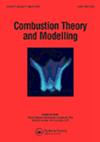Effects of artificial flame front thickening on intermediate minor species prediction using the LES–FGM method
IF 1.6
4区 工程技术
Q4 ENERGY & FUELS
引用次数: 0
Abstract
Two stratified premixed Cambridge/Sandia flames SwB1 and SwB9 are modelled using the Flamelet-Generated Manifold in the context of Large-eddy Simulation. Two kinds of sub-grid closure models are adopted and systematically compared, that is, the Dynamically Thickened Flame (DTF) and the Presumed Probable Density Function (PPDF) models, in order to study the effects of artificial flame front thickening introduced by the DTF on the intermediate minor species prediction. It is found that the two methods lead to similar modelling of velocity, temperature, mixture fraction and major species (e.g. CH , O , CO and H O). However, the intermediate minor species CO and H can be over-predicted using the DTF model compared to the PPDF. A correction method proposed recently by Gruhlke et al. is validated in this work to improve the CO/H predictions of DTF. The corrected CO/H mass fractions are nearly consistent with the results of PPDF. It is examined that the Gruhlke-correction performs better if the wrinkling factor is used directly without modification. Meanwhile, the correction exhibits similar good performance with different level of flame front thickening and mixture stratification. The correction is also addressed to correct the species only in the flame front. The results are significant in high-fidelity simulation of intermediate species using the DTF model.人工火焰锋增稠对LES–FGM方法预测中小物种的影响
在大涡模拟的背景下,使用小火焰生成歧管对两个分层预混剑桥/桑迪亚火焰SwB1和SwB9进行建模。采用动态增稠火焰(DTF)和假定概率密度函数(PPDF)两种亚网格闭合模型,并对其进行了系统的比较,以研究DTF引入的人工火焰锋增稠对中、微量物种预测的影响。研究发现,这两种方法对速度、温度、混合物分数和主要物质(如CH、O、CO和HO)进行了相似的建模。然而,与PPDF相比,使用DTF模型可以过度预测中间次要物种CO和H。Gruhlke等人最近提出的一种校正方法在这项工作中得到了验证,以改进DTF的CO/H预测。校正后的CO/H质量分数与PPDF的结果几乎一致。检验表明,如果直接使用褶皱因子而不进行修改,Gruhlke校正效果更好。同时,在不同程度的火焰锋增稠和混合物分层的情况下,修正表现出相似的良好性能。校正也被处理为仅在火焰前沿校正物种。该结果对使用DTF模型的中间物种的高保真度模拟具有重要意义。
本文章由计算机程序翻译,如有差异,请以英文原文为准。
求助全文
约1分钟内获得全文
求助全文
来源期刊

Combustion Theory and Modelling
工程技术-工程:化工
CiteScore
3.00
自引率
7.70%
发文量
38
审稿时长
6 months
期刊介绍:
Combustion Theory and Modelling is a leading international journal devoted to the application of mathematical modelling, numerical simulation and experimental techniques to the study of combustion. Articles can cover a wide range of topics, such as: premixed laminar flames, laminar diffusion flames, turbulent combustion, fires, chemical kinetics, pollutant formation, microgravity, materials synthesis, chemical vapour deposition, catalysis, droplet and spray combustion, detonation dynamics, thermal explosions, ignition, energetic materials and propellants, burners and engine combustion. A diverse spectrum of mathematical methods may also be used, including large scale numerical simulation, hybrid computational schemes, front tracking, adaptive mesh refinement, optimized parallel computation, asymptotic methods and singular perturbation techniques, bifurcation theory, optimization methods, dynamical systems theory, cellular automata and discrete methods and probabilistic and statistical methods. Experimental studies that employ intrusive or nonintrusive diagnostics and are published in the Journal should be closely related to theoretical issues, by highlighting fundamental theoretical questions or by providing a sound basis for comparison with theory.
 求助内容:
求助内容: 应助结果提醒方式:
应助结果提醒方式:


